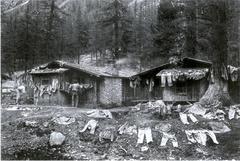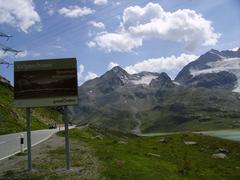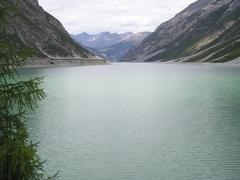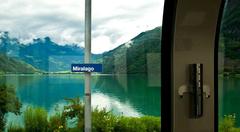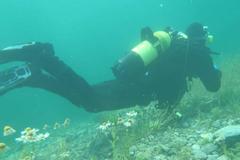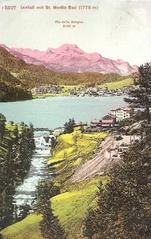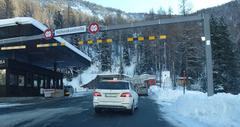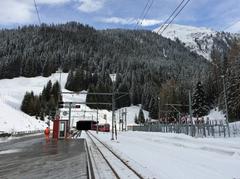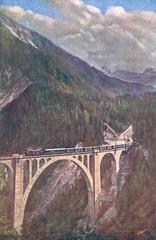
Marmels Castle: Visiting Hours, Tickets, and Complete Guide to Grisons Historical Sites
Date: 04/07/2025
Introduction: Discover Marmels Castle in the Canton of Grisons
Perched dramatically above the Lai da Marmorera reservoir in Switzerland’s Canton of the Grisons (Graubünden), Marmels Castle (German: Burg Marmels) is a remarkable example of medieval ingenuity and adaptation to the Alpine environment. As a “Grottenburg,” or cave castle, Marmels is ingeniously constructed beneath a massive rock shelter, blending seamlessly into its rugged natural setting. Originally established by the influential Marmels family in the late 12th century, the castle served as a strategic stronghold, controlling vital alpine trade and pilgrimage routes. Its remote location and unique architecture make Marmels Castle an exceptional historical site—offering visitors not only a glimpse into the region’s feudal and ecclesiastical past but also breathtaking panoramic views.
Today, Marmels Castle stands as one of Switzerland’s best-preserved medieval ruins, renowned for its rare archaeological finds and integration with the natural landscape. Accessible only by a challenging hiking trail, the site rewards adventurous visitors with evocative ruins, insights into medieval life, and a tangible connection to the history of the Grisons. This guide provides detailed information on the castle’s history, architecture, visitor access, travel tips, and nearby attractions—equipping you for an enriching and safe visit.
For authoritative historical context and updates, consult the Graubünden Tourism portal and comprehensive archaeological research (Propylaeum).
Table of Contents
- Introduction
- Historical Background and Early Significance
- The House of Marmels: Rise and Influence
- Architecture and Archaeological Discoveries
- Political and Cultural Importance
- Decline and Preservation
- Visiting Information
- Travel Tips and Nearby Attractions
- Sustainability and Responsible Tourism
- Frequently Asked Questions (FAQ)
- Additional Resources & Call to Action
- Sources
Historical Background and Early Significance
First mentioned in 1193, Marmels Castle was likely established earlier by the noble Marmels family, who served as ministerials to the Bishop of Chur (Wikipedia). The castle’s location, perched over 1,700 meters above sea level, offered natural defenses and enabled its owners to control critical alpine routes through the Julier and Septimer passes—vital arteries for medieval commerce and pilgrimage (Showcaves.com).
The Marmels family’s tenure was notable for its continuity—rare among minor nobility—further cemented by their role in regional politics and ecclesiastical affairs. The capture of the papal Cardinal Legate Cintius in 1193 by Andreas von Marmels highlights the castle’s strategic importance as both a military outpost and a political power base (Swisscastles.ch).
Architecture and Archaeological Discoveries
Strategic Layout
Marmels Castle is masterfully integrated into a massive rocky overhang along a narrow ridge high above the Marmorera reservoir. The core complex includes a multi-storey residential tower (keep), a chapel with remnants of medieval frescoes, and various service structures. The curtain wall and overhanging cliff provided formidable defense, making direct assault difficult. Access to the site remains challenging, echoing the logistical hurdles faced by residents centuries ago (Propylaeum).
Construction Techniques and Organic Finds
Dendrochronological analysis dates the main construction to around 1140 CE. Builders used locally sourced stone and timber, employing the natural rock as part of the defensive structure. The dry, sheltered microclimate beneath the ledge preserved an exceptional cache of organic materials—over 1,000 wooden objects, leather fragments (including shoes), and parchment pieces, some inscribed with writing. These rare finds provide unique insights into medieval Alpine daily life (Propylaeum; Burgenwelt.org). Archaeological excavations have also catalogued thousands of animal bones and plant remains, revealing details of diet and resource use.
Political and Cultural Importance
Throughout its functional centuries, Marmels Castle was a seat of both secular and ecclesiastical power. The Marmels family governed nearby villages and managed critical alpine routes, collecting rents and administering justice. The castle’s chapel and religious artifacts underscore its dual role as an administrative and spiritual center. Its story reflects broader patterns of feudal allegiance, the assertion of local autonomy, and the region’s evolving political landscape (Schreiberschreibt).
Decline and Preservation
Inhabited into the mid-16th century, Marmels Castle was ultimately abandoned as political and economic centers shifted and military technology rendered its defenses obsolete. An earthquake in 1905 caused further damage, but the castle’s remote, protected location has ensured the survival of significant ruins and organic materials. Today, Marmels is a protected archaeological zone, with conservation efforts focused on preserving both its built heritage and unique archaeological context (Swisscastles.ch; Swissglorious.com).
Visiting Marmels Castle: Hours, Tickets, and Accessibility
Access and Location
- Village Base: The closest village is Marmorera, located about 30 km southwest of Chur.
- Trailhead: Start from the parking area near the Marmorera dam.
- Hike: The moderately challenging trail ascends steeply through alpine forest and meadows, taking 45–60 minutes (approx. 250 m elevation gain).
- Trail Condition: Narrow, rocky, and exposed in places—recommended only for experienced hikers.
Visiting Hours and Tickets
- Hours: Open-air site accessible year-round, but best visited from May to October when trails are clear.
- Tickets: No entrance fee; the site is freely accessible (Graubünden Tourism).
Facilities and Accessibility
- On-site Facilities: None. No restrooms, food vendors, or shelters. Bring all necessary supplies.
- Accessibility: The trail is not suitable for wheelchairs, strollers, or those with significant mobility limitations. Families with young children should take extra care.
Trail Safety and Preparation
- Footwear: Sturdy hiking boots are essential.
- Weather: Avoid visiting in rain, snow, or fog. The trail can become hazardous in poor conditions.
- Essentials: Bring water, snacks, sun protection, layered clothing, and a charged phone.
- Emergency: Dial 144 for mountain rescue.
Guided Tours and Interpretation
- No regular tours are offered on-site. Occasionally, local tourism offices organize historical walks or group hikes including the castle. Interpretive signage is limited; for in-depth context, consult resources at the Rhaetian Museum in Chur.
Best Times to Visit & Tips
- Season: Late spring through early autumn (May–October) is optimal for clear trails and favorable weather.
- Timing: Early morning or late afternoon provides soft light for photography and fewer visitors.
- Photography: Capture panoramic views of the Surses valley, Marmorera reservoir, and castle ruins at sunrise or sunset.
- Wildlife: The area is home to marmots, ibex, and a variety of birds. Observe respectfully.
Sustainability and Responsible Tourism
- Stay on Trails: Protect flora and prevent erosion.
- Take Nothing, Leave Nothing: Do not disturb ruins or remove artifacts; pack out all litter.
- Support Local: Use services in Marmorera, Savognin, or nearby villages.
- Fires & Dogs: Fires are strictly prohibited. Dogs must be leashed and accustomed to steep trails.
Nearby Attractions and Regional Heritage
- Lai da Marmorera Reservoir: Ideal for scenic walks, picnics, and nature observation.
- Savognin: Offers restaurants, accommodations, and local culture.
- Parc Ela: Switzerland’s largest nature park with extensive hiking and biking trails (Graubünden tourism).
- Other Castles: Explore regional fortresses like Tarasp and Sargans (Tarasp Castle; Sargans Castle).
Frequently Asked Questions (FAQ)
Q: What are the opening hours of Marmels Castle?
A: The site is accessible year-round during daylight hours; best visited from late spring to early autumn.
Q: Is there an entry fee or are tickets required?
A: No, entry is free and no tickets are required.
Q: How do I get there by public transport?
A: Take the train to Tiefencastel, then a PostBus to Marmorera. From there, follow the marked hiking trail.
Q: Is the site suitable for children or visitors with mobility issues?
A: The hike is steep and exposed; not recommended for young children, wheelchairs, or those with limited mobility.
Q: Are guided tours available?
A: No regular tours. Occasionally, local tourism offices organize group hikes.
Q: What should I bring?
A: Hiking boots, water, snacks, weather-appropriate clothing, sun protection, and a camera.
Call to Action and Further Exploration
Ready to explore Marmels Castle and the captivating heritage of the Grisons? Download the Audiala app for guided audio tours, interactive maps, and up-to-date visitor information. Check our related articles for more hidden gems, and follow us on social media for the latest Swiss travel inspiration.
For official updates and planning resources, consult:
Visual Gallery
Summary and Final Tips
Marmels Castle stands as a distinctive chapter in Swiss medieval history—its architecture, strategic setting, and rare archaeological finds offering a window into the feudal, ecclesiastical, and everyday life of the Grisons. Its free, year-round access (weather permitting) and evocative ruins make it an ideal destination for experienced hikers and history lovers eager to immerse themselves in Switzerland’s alpine heritage. Prepare well, respect the site, and enjoy one of the country’s most unique historical adventures.
Sources
- Marmels Castle Wikipedia
- Showcaves.com: Marmels Castle
- Swisscastles.ch: Marmels Castle
- Graubünden Tourism: Marmels Castle
- Propylaeum: Research on Marmels Castle
- Burgenwelt.org: Marmels Castle
- Val Surses Tourism: Burgruine Marmels
- Schreiberschreibt: Historic Buildings in Canton of Grisons
- Rhaetian Museum – Castles of Graubünden
- MySwitzerland: Attractions in Graubünden
- Mindfulpnwtravels.com: Castles in Switzerland
- Swissglorious.com: Marmels Castle and Towns









